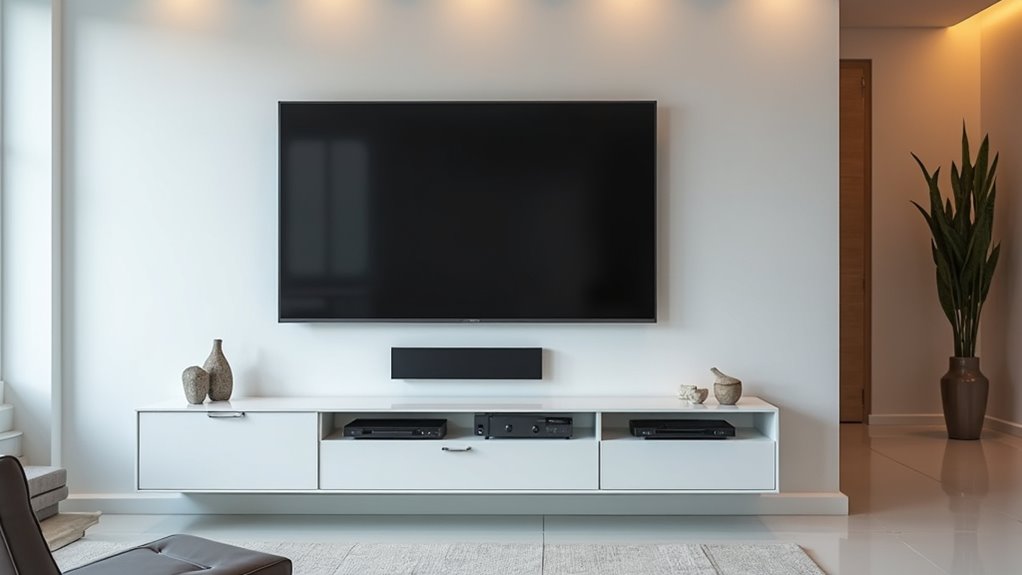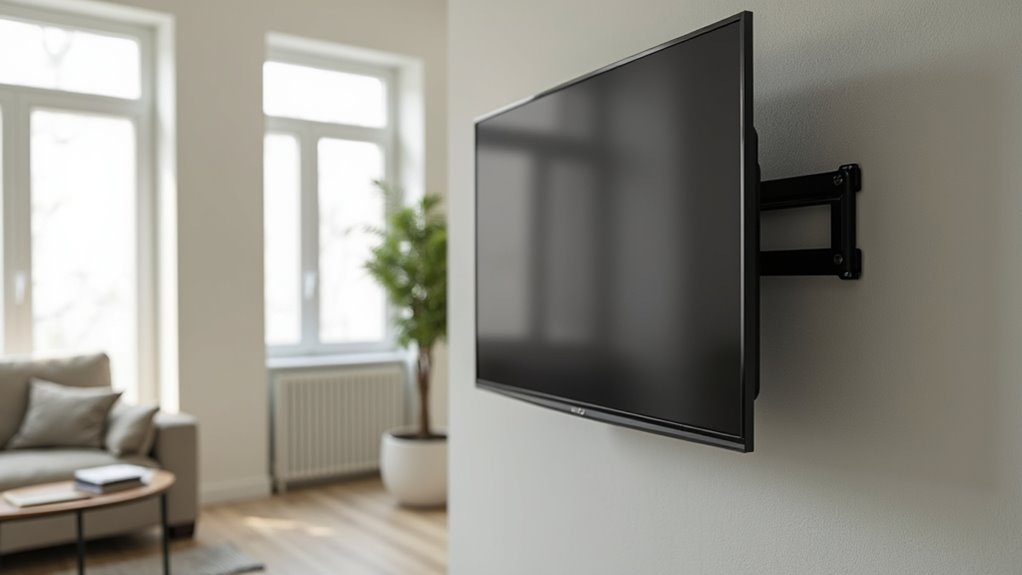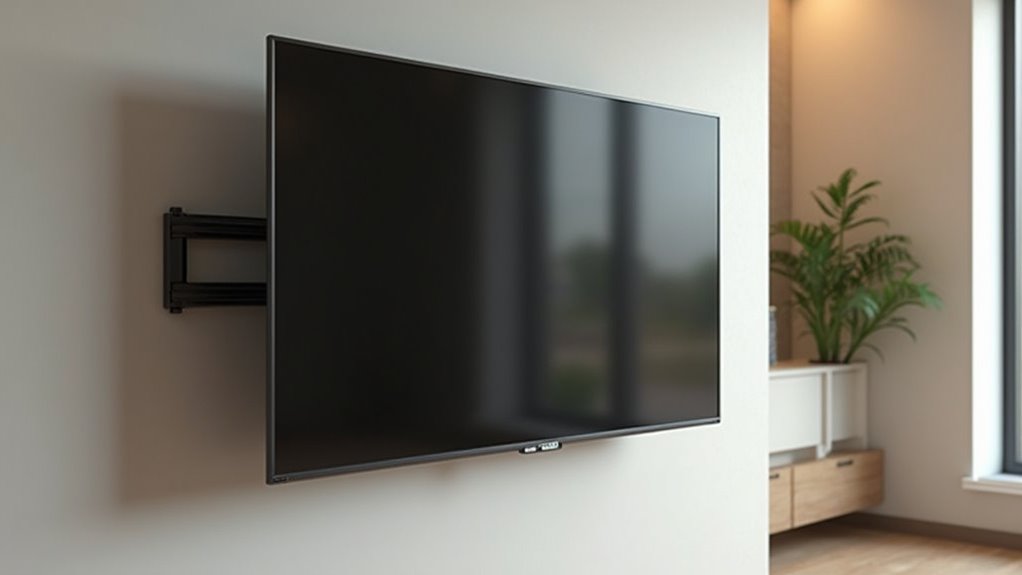Torn between taking your TV mount or leaving it behind? Moving day brings enough stress without worrying about fixtures and fittings that blur ownership lines. Buyers might expect all mounted items to stay, while sellers may want to keep their expensive brackets. Fortunately, understanding real estate norms and communication can prevent this common closing dispute.
When selling a house, TV mounts typically stay with the property as they’re considered permanent fixtures. Most real estate contracts assume wall-mounted brackets transfer to the new owner unless specifically excluded in writing. Think of them like curtain rods or built-in shelving that remain attached to walls.
In this blog I will explore everything about TV mounts when selling homes, from legal considerations to practical solutions.
Key Takeaways
- TV mounts are generally considered fixtures and typically remain attached when selling a house.
- Including TV mounts in the sale should be clarified in the listing and sales contract.
- Leaving the mount in place is common practice to avoid wall damage and simplify the sale process.
- If removal is desired, it should be communicated early, and professional help may be recommended.
- Clear documentation and disclosure prevent disputes over whether mounts stay or go.
Do You Leave TV Mounts When Selling a House?

Do You Leave TV Mounts When Selling a House?
TV mounts typically stay with the house when you sell. They’re considered fixtures attached to the wall. Most real estate contracts classify permanently attached items as part of the property. Your local laws might’ve specific guidelines about this.
Check your sales agreement for clarity. Buyers usually expect mounts to remain unless stated otherwise. To avoid misunderstandings, specifically mention TV mounts in your listing description.
Furthermore, clear communication prevents last-minute disputes. You can always negotiate with buyers if you want to take the mounts. However, you should document any agreements in writing.
What Does a Standard Home Sale Include?

A standard home sale includes fixtures and permanently attached items to the property. Built-in appliances, attached lighting, and wall mounts transfer with the house.
Legal contracts specify these inclusions unless explicitly excluded in the purchase agreement. Personal items like furniture, wall art, and decor remain with the seller. However, some items fall into a gray area.
For instance, additional fixtures or special features might become negotiation points between buyers and sellers. Clear communication about what stays prevents future disputes. Moreover, documenting all agreements protects both parties throughout the transaction process.
Are TV Mounts Fixtures or Personal Property?

TV mounts are typically considered fixtures if they’re bolted or screwed into the wall because they become part of the property.
However, the actual TV is personal property unless permanently attached to the mount. Clarifying whether mounts are included or excluded in your sale depends on their attachment and your agreement.
Definition of Fixtures in Real Estate
Fixtures are physical items permanently attached to property. They legally transfer with the property during a sale. Common examples include built-in appliances, light fixtures, and TV mounts. These items must show clear attachment and intent to remain part of the property.
The primary test considers how the item connects to the property. Real estate contracts should specifically list any fixtures the seller plans to remove. This prevents misunderstandings during closing.
Buyers can also negotiate to keep certain items that mightn’t qualify as fixtures. Moreover, state laws may differ on what constitutes a fixture. Documentation in purchase agreements creates clarity for all parties.
When TV Mounts are Considered Fixtures
TV mounts are fixtures when permanently attached to walls. They’re typically considered part of the home during a sale. Wall brackets secured with screws or bolts qualify as permanent fixtures.
Built-in mounts designed as permanent improvements also count as fixtures. Attachment methods matter greatly in this determination. Sellers should clarify fixture status in listing agreements. This prevents misunderstandings during closing.
Conversely, loosely hanging mounts are usually personal property. The intent behind installation plays a crucial role too. Furthermore, local real estate laws might’ve specific definitions for fixtures.
When TV Mounts May Be Personal Property
TV mounts can be personal property when installed without permanent attachment. Mounts placed loosely or with temporary hardware typically remain the seller’s property.
Home selling standards recommend explicit discussion about TV mounts before closing process. The seller’s intent matters significantly in determining ownership status. Many disputes arise when expectations differ between buyers and sellers.
For clarity, document mount ownership directly in your purchase agreement. This simple step prevents misunderstandings later. Removability is a key factor in the personal property determination. Most real estate agents recommend treating easily detachable mounts as personal items unless specified otherwise.
What Do Most Home Sellers Choose to Do?
Most home sellers choose to leave TV mounts and other fixtures attached to the home when selling. This practice follows standard real estate conventions nationwide. Under Ohio law, permanently attached items typically transfer with the property. Sellers find this approach reduces hassle.
Property transfers go more smoothly when fixtures remain in place. Removing mounted items often causes wall damage requiring repairs. Additionally, buyers generally expect these items to stay with the home.
To avoid misunderstandings, sellers should clearly list all included fixtures in the sales agreement. In essence, leaving fixtures in place serves both parties well.
How to Address TV Mounts in Your Real Estate Listing?
Be clear in your listing about whether TV mounts stay or go by documenting it explicitly. Use property disclosure statements and include photographs to show the mounts’ condition and location. This transparency helps set expectations and reduces strong legal disputes.
Clear Documentation in Listing Description
State whether TV mounts are included in your listing. This prevents confusion and disputes later. Real estate contracts should accurately reflect your intentions about fixtures. Your description must explain if wall mounts stay or go after sale. Buyers need this information to make informed decisions.
Clear communication helps align everyone’s expectations from the start. The documentation serves as reference if questions arise during closing.
Most states consider permanently attached fixtures part of the property unless specifically excluded. Remember to be specific about all fixtures, not just TV mounts. This transparency builds trust with potential buyers.
Inclusion in Property Disclosure Statements
TV mounts should be listed in your property disclosure statement. This prevents disputes during home sales. You must clearly note whether mounts stay with the property or will be removed. Most states require disclosure of all attached fixtures in real estate transactions.
Transparency benefits both parties in the transaction. Buyers know exactly what they’re purchasing with the home. Sellers avoid potential legal issues after closing.
Furthermore, documentation protects you if disagreements arise later. The listing should specify mount locations and condition. This small detail can prevent significant headaches during closing.
Photographs and Visual Documentation
Clear photos directly show if TV mounts are included with the property. Take pictures of wall mounts and brackets to document their presence. Your listing should clearly state whether these items stay or go.
Photos prevent confusion during negotiations and help avoid disputes after closing. Buyers can see exactly what fixtures remain in the home.
Visual evidence creates transparency throughout the selling process. Most states require sellers to disclose all items included in the sale. The documentation serves as proof if questions arise later. This approach leads to smoother transactions and satisfied buyers.
What Legal Implications Should You Consider?
You need to understand how Ohio law classifies fixtures like TV mounts, as they’re generally considered part of the property if attached permanently.
Your sales contract should clearly specify whether mounts stay or go, since ambiguity can lead to disputes. Being aware of strong legal issues helps you avoid costly conflicts and ensures a smooth transaction.
State-Specific Real Estate Laws
TV mounts in Ohio typically stay with the property when sold. Wall-mounted TV fixtures legally transfer to the buyer unless specifically excluded in the purchase agreement. This follows standard fixture laws in Ohio real estate transactions.
You should clearly document your intentions about TV mounts before closing. Specify in writing whether mounts will remain or be removed. This simple step prevents potential disputes later.
Furthermore, early communication with buyers about fixtures saves everyone time and frustration. Ohio law considers permanently attached items part of the real property. This approach protects both parties throughout the sale process.
Contract Language and Specifications
TV mounts should be explicitly addressed in your purchase agreement. Clear contract specifications prevent legal disputes when selling a house. Ohio law considers TV mounts as fixtures that transfer with real property. Both buyers and sellers benefit from documenting their intentions regarding these items.
Proper documentation protects all parties involved in the transaction. Your contract should state whether mounts stay or go with the seller. This simple step eliminates confusion later in the process. As a result, the closing proceeds more smoothly without unexpected conflicts.
Furthermore, detailed agreements allow for proper negotiation of these items. The sale will progress without interruption when expectations are established early. In essence, clear language serves everyone’s interests and supports a successful property transfer.
Potential Disputes and Resolutions
TV mount ownership disputes arise from unclear contract terms. State fixture laws typically determine whether mounts remain with the property.
Sellers should address these items before listing to avoid conflicts. Buyers must clarify their expectations early in negotiations.
Written agreements prevent most disputes effectively. Specifically document which items stay and which items go with the seller. Additionally, photographs with dated signatures provide solid evidence if questions arise later.
Damage claims often result when sellers remove fixtures improperly. Mediation offers a cost-effective solution for resolving disagreements outside court. Most importantly, good communication prevents these problems entirely.
How to Remove TV Mounts If You Decide to Take Them?
To remove a TV mount safely, start by disconnecting the TV and unscrewing the mount from the wall. Then, carefully patch any holes with spackle or wall filler, and sand the area smooth before repainting. Whether you do it yourself or hire a professional depends on your comfort with tools and the extent of wall damage.
Proper Wall Repair Techniques
The correct way to fix walls requires patching and repainting after removing fixtures. Start by taking out all mounting screws with a screwdriver. Pull the mount away gently, using a pry bar if necessary. Fill holes with spackle using a putty knife and let dry completely.
Once dry, sand the patched spots until smooth. Apply matching paint over the repaired area for a seamless look. Follow the five-step process: remove screws, detach mount, patch holes, sand surface, and repaint wall. This method prevents further damage and restores your wall’s appearance.
Timeline for Removal
Remove TV mounts at least two weeks before your first home showing. This allows ample time to patch and repaint walls properly.
The mount should come down before your TV to prevent wall damage during the process. Always check your sales contract to confirm which fixtures must stay with the home.
Most standard contracts require permanent fixtures like built-in wall mounts to remain with the property. Your real estate agent can provide guidance on specific requirements.
For a smooth transition, patch all holes immediately after removal and allow sufficient drying time before painting. This thoughtful timing prevents last-minute repair rushes before important showings.
Professional vs. DIY Removal
Professionals are better for complex TV mount removals, while DIY works for those comfortable with basic tools. Professionals have proper equipment and experience to prevent wall damage. They complete the job quickly and often include patching services.
You can remove simple mounts yourself if you own basic tools and feel confident with repairs. The TV itself remains your personal property regardless of who removes the mount. First locate all screws, then support the bracket while removing them.
Remember to patch and paint the holes afterward for a clean finish. This step maintains your wall’s appearance and preserves property value.
Sell Your House As-Is with TV Mounts Included to Prestige Investments Cincinnati
TV mounts can be included when selling your house to Prestige Investments Cincinnati. Under Ohio law, fixtures like TV mounts typically stay with the property unless specified otherwise. This arrangement reduces your selling stress and simplifies the transaction.
Be clear about mounted items in your listing and sales agreement. The documentation helps prevent misunderstandings later. Most buyers appreciate having functional mounts already installed.
Make sure any mounts you leave behind are secure and safe. Properly installed fixtures can help your home pass inspection requirements. This attention to detail serves both your interests and meets the buyer’s expectations.
Frequently Asked Questions
Can I Legally Remove TV Mounts Before Selling My House in Ohio?
Yes, you can legally remove TV mounts before selling your house in Ohio, but you should do so carefully to avoid wall damage. It’s best to negotiate and document this in the sale agreement to prevent disputes.
Are TV Mounts Considered Fixtures Under Ohio Law?
Under Ohio law, TV mounts screwed or bolted into the wall are fixtures because they’re permanently attached and intended as improvements. Clarify in your sales contract whether you’re leaving or removing them to prevent disputes.
Should I Specify TV Mount Inclusion in My Sales Contract?
Envision your sales contract as a map guiding your deal. You should specify TV mount inclusion clearly, so both parties know the terrain—avoiding surprises, legal disputes, and ensuring a smooth journey to closing.
How Do I Handle Wall Damage Caused by Removing Mounts?
You should repair wall damage caused by removing mounts promptly. Fill holes, sand smoothly, and repaint as needed. Communicate these repairs with your buyer or agent to ensure transparency and avoid disputes during closing.
What Is the Typical Practice for TV Mounts in Cincinnati Home Sales?
In Cincinnati, the typical practice is to negotiate and clearly document whether the TV mount stays or is removed. Most follow Ohio laws, considering mounts fixtures, so specify your intent in the sales contract to avoid disputes.
Conclusion
Ultimately, understanding whether to leave or remove your TV mounts depends on clarity and communication. Clearly convey your decision in your contract, consider legal and local practices, and document details diligently. Whether you choose to leave mounts as part of the property or take them along, approach the process with transparency and tact. This pragmatic, proactive plan ensures a smooth sale, sidesteps disputes, and secures a satisfying sale success.





